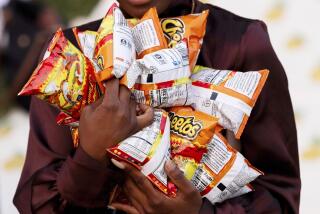In-N-Out to remove red dye No. 3 from its strawberry milkshake and pink lemonade

- Share via
In-N-Out fans looking to satisfy a craving for a strawberry milkshake, pink lemonade or ketchup-drenched french fries might soon notice something a bit different.
The beloved burger spot, known for its limited menu and animal-style offerings, is changing its popular strawberry shake and signature pink lemonade recipes to remove red dye No. 3, an In-N-Out spokesperson told The Times on Wednesday. Red dye No. 3 is a synthetic additive used to give foods and drinks a bright red hue.
In-N-Out is also in the process of changing its ketchup to remove high-fructose corn syrup and replace it with cane sugar, the company’s spokesperson said.
The recipe changes come on the heels of an April announcement by the U.S. Food and Drug Administration, which asked companies to more quickly remove red dye No. 3. The agency announced earlier this year that it is banning the dye because it was found to cause cancer in some lab animals.
The FDA has said it doesn’t view the dye as harmful to people since the biological process through which the dye causes cancer in rats doesn’t occur in people. Also, humans consume red dye No. 3 at levels far lower than those shown to cause cancer in two studies of rats, according to the FDA.
The FDA previously gave food manufacturers until 2027 to remove red dye No. 3 from their products. Under the Delaney Clause, the FDA is mandated to ban any food or color additive known to cause cancer, even if just in animals.
Robert F. Kennedy Jr. announced Tuesday that the Department of Health and Human Services will work toward eliminating more than half a dozen common dyes from the U.S. food supply.
It is not clear what ingredient will replace red dye No. 3 at In-N-Out.
Many In-N-Out enthusiasts wrote on social media that they’d stick with brand through the recipe changes. Some offered their own suggestions for improving the menu.
“I love In-N-Out. No big deal,” San Fernando Valley resident Samuel Almanza said in a Granada Hills Facebook group.”If it’s healthier I’m all for it.”
One Facebook user said she could taste the artificial syrups and another suggested adding real strawberry chunks to the milkshake and lemonade.
Other fast food restaurants may also soon be forced to change menu items after the FDA approved the removal of six synthetic dyes from food products by the end of 2026.
Jack in the Box, founded in 1951 in San Diego, uses maraschino cherries and has a Fanta strawberry beverage that contains red No. 40 — an ingredient on the chopping block next year.
“Jack in the Box is committed to providing our customers craveable food made with quality ingredients. As part of this commitment, we make detailed ingredient information publicly available on our website,” spokesperson Casey Middleton said in an emailed statement. “While some of our menu items do contain FDA-approved color additives, red dye 3 is not used in any of our products.”
The FDA banned the use of red dye No. 3 in foods and medicines sold in the U.S. because it has been shown to cause cancer in rats. The action highlights the limits of a federal law known as the Delaney clause.
McDonald’s, which started in San Bernardino in 1940, said on its website that its menu items do not contain red dye No. 3.
Other soon-to-be banned dyes are green No. 3, yellow Nos. 5 and 6, and blue Nos. 1 and 2. Last week, the FDA approved three natural color additives — calcium phosphate, Galdieria extract blue and butterfly pea flower extract — to replace them.
Calcium phosphate is a naturally occurring mineral found in bones and teeth. In food, calcium phosphate is used as a whitening agent. The FDA has approved the use of calcium in ready-to-eat chicken products, white candy melts, doughnut sugar and coated candies.
Galdieria extract blue comes from a unicellular red algae, which is an organism that thrives in extreme marine and terrestrial environments, according to the National Institutes of Health. Galdieria extract blue was approved as a color additive in beverages such as fruit drinks, smoothies and juices.
Butterfly pea flower extract is derived from a clitoria ternatea plant, often used as a natural food colorant, according to the NIH. The plant has a bright blue color that, when mixed with acid, turns to an intense purple. The extract was approved for use in sports drinks, alcoholic beverages and teas.
“On April 22, I said the FDA would soon approve several new color additives and would accelerate our review of others. I’m pleased to report that promises made, have been promises kept,” FDA Commissioner Martin A. Makary said. “FDA staff have been moving quickly to expedite the publication of these decisions, underscoring our serious intent to transition away from petroleum-based dyes in the food supply and provide new colors from natural sources.”
More to Read
Sign up for Essential California
The most important California stories and recommendations in your inbox every morning.
You may occasionally receive promotional content from the Los Angeles Times.













